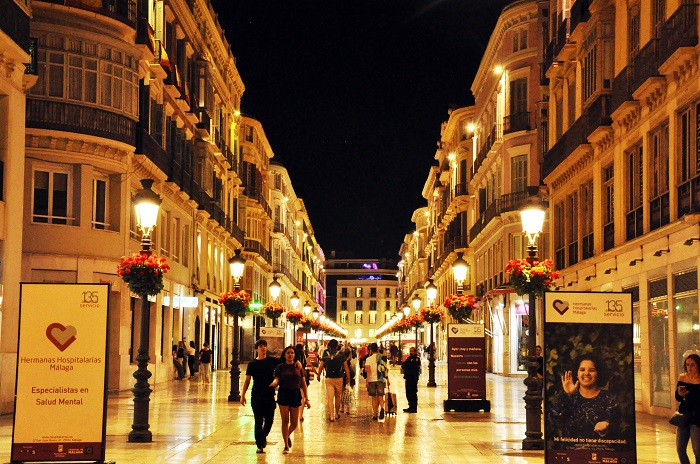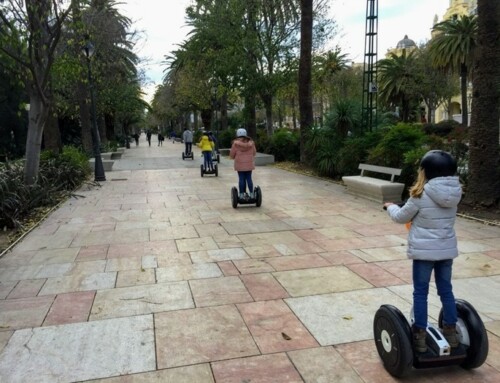The last frontier to the real life lies past the ‘Jaboneros’ stream, as a counterpoint to the Malaga of cruise ships and museums. In ‘El Palo’ you can have grilled sardines, but also Hawaiian ‘poké’. You can go paddle surfing or row in a ’jábega’ (fishing boat from Malaga). Do you want to discover its secrets? Come along with us!
Without losing its naval heritage out of sight, this neighborhood is modernizing in a slow but steady way to such an extent that it has become the new temptation in Malaga.
Arnault Scheidhauer was born in France, in the Normandy region. When he was ten, he moved to ‘El Palo’. He grew up, and for a couple of years he traveled all over Asia, visiting countries like Nepal, Myanmar or Laos. Finally, he decided to open a restaurant in Malaga. He weighed his options, analyzed the center of Malaga and came to the conclusion that this wasn’t his place.
So he returned to his roots, and looked for a small place with personality, under the recognizable green shaded buildings of ‘Echevarría del Palo’. He named it ‘La Revuelta’, and took the flavors from his travels and his know-how as a chef with him.
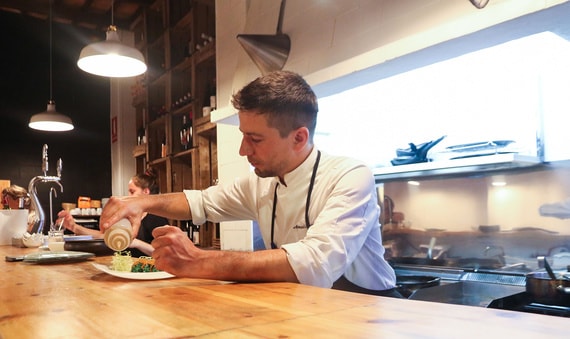
Arnault, La Revuelta © Nacho Sánchez
As a kitchen artisan, Arnault offers dishes with a clear personal stamp, which he serves right at the bar, so you can see there are no secrets. “Everything is fresh, made at the moment”, he says.
To help you choose from the menu, Marta (a girl from Cantabria that he met in Barcelona), tells you the story of each dish, whether it’s sea urchin with rice, seaweed with parmesan cheese, a grouper hamburger with oyster sauce, sea bass taco with truffle or crab in the wok with udon and a chili custard.‘La Revuelta’ celebrated its first birthday in the end of April and has turned into a local culinary reference. A good example to show that Malaga is more than its historic center and that something is changing in a neighborhood that has always lived bound to tradition: El Palo.
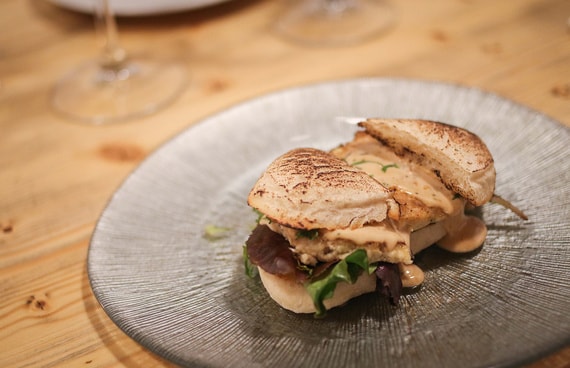
Grouper hamburger at La revuelta © Nacho Sánchez
The area has converted to the last frontier with reality in a city that today lives from, and for, tourism. With an offer that doesn’t stop growing, a lot of people fear Malaga will become the next Barcelona (if it hasn’t done so already).
Nonetheless, territory of ‘El Palo’ still shows a face that resembles that of a few decades ago. And, although it hangs on to its history and its essence, it’s clear that modernity is welcomed, as long as it comes with common sense and respect.
This is why in the last years some new places (La Revuelta, for example) opened to refresh the panorama of El Palo, without it moving too far from what it really is: a place where the people are the main asset. And where they still say they’re going ‘down to Malaga’ when they get on the bus.
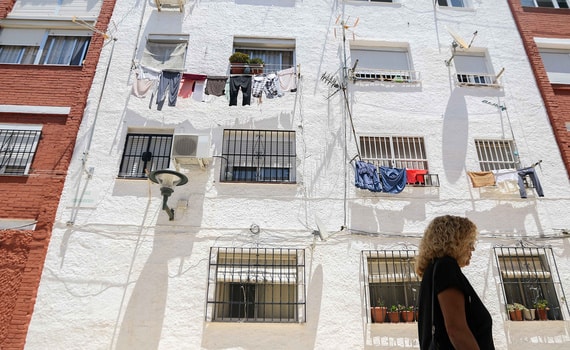
El Palo neighborhood © Nacho Sánchez
The ‘Jaboneros’ stream (always dry unless it’s pouring down) is the imaginary border between the capital of the Costa del Sol and the fisher’s village where the streets only got paved in the mid 80’s, and which looks like a small town.
It has a football field, a market, a police station and even its own cemetery. There’s not even one hotel, but there are two beaches and a mountain: you can go up to the hills known as ‘las tetas de Málaga’, ascending on the ‘Villa Cristina’ slope and passing through the ‘Pinares de San Antón’ urbanization, where the chameleons live.
They even have a team in the traditional fishing boat league, and a construction competition that is on its way to its 51st edition, organized by ‘Peña el Palustre’, where every Sunday you can hear the numbers being called out for the popular ‘Bingo’ game.
Apart from that; gastronomy, townhouses, tranquility, life outside, and neighbors that know each other. You can even find work from urban artist ‘Invader’. These are just some of the reasons why a neighborhood –that was never considered especially ‘great’ in the city- is now one of the most sought-after places to live.
‘El Palo’ has its best days in July, celebrating the festivity of ‘Virgen del Carmen’, patron saint of the fishermen, that honors her with a procession that leads right into the sea. A lot of those fishermen still live in small houses by the beach, with the boardwalk as their living room.
It’s easy to spot the families enjoying their lunch at the doors of their houses, as well as the dinners that go on until dawn, with the sound of Parcheesi tiles as a soundtrack.
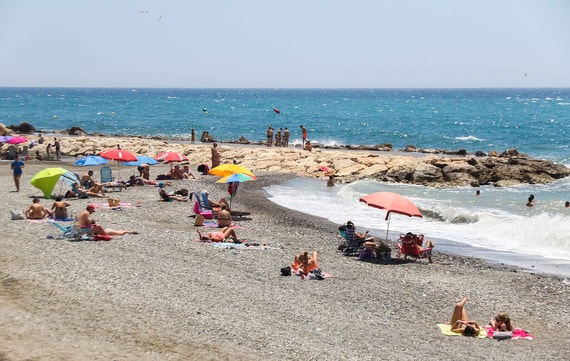
El Palo beach © Nacho Sánchez
In front of them sometimes young foreigners pass by on a bike, or practicing paddle surf thanks to ‘Kayak y Bike’, a business that is also a good example of ‘El Palo’s’ update to the 21st century. Its responsible is José Dominguez, but in the neighborhood everyone knows him as ‘Dino’.
The crisis ended his career as an electrician, but his ingenuity and efforts allowed him to convert a house full of rubble by the sea into a shop where you can rent kayaks, surf boards and bicycles, and where a lot of the neighbors keep their gear to practice nautical sports.
“I went to Nerja and saw that this was a good idea that nobody had started yet here, so I took the plunge”, says this ‘paleño’, grandson of Cenachero (traditional fish vendor from Malaga) that knew how to use the Mediterranean to his advantage.
“There’s almost no fishing anymore, but this is our treasure and I wanted to make a living of it”, he adds, whilst speaking English to some clients that just came back from a two-wheeled tour.
In the shop, also his home, a bar and three tables give you the opportunity to freshen up after all the effort. The business just turns one year, and the summer hustle almost leaves him no time to rest, thanks to tourism. In the winter it’s the locals that enjoy the climate of Malaga to go and have a ‘walk on water’.
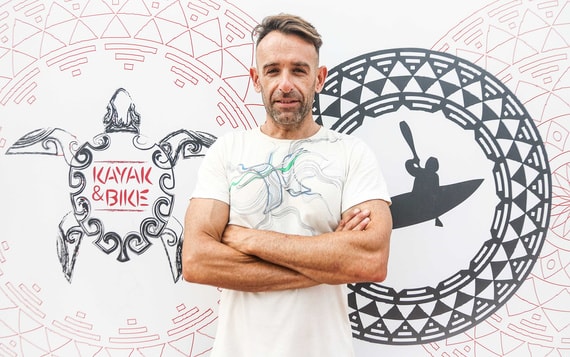
Kayak & Bike © Nacho Sánchez
Among the houses facing the beach you can find some of the most vintage ‘chiringuitos’ in the city, especially now that the historic ones of neighboring district ‘Pedregalejo’ are disappearing at a dizzy rate.
One of the classics is ‘El Zagal’. This ‘chiringuito’ first saw the light in 1971 as a tavern, a time when Jesús Jiménez ran around the tables when he was little, and his mother, Antonia, started making her prestigious paellas. Back then, they served beer and the fresh catch the fishermen brought in every morning. Today, Jesús runs the place with his brothers, although it still belongs to his father (José El Zagal).
Of course it doesn’t have ‘chill out’ music, nor do they serve cocktails with names impossible to pronounce. In exchange, they offer some of the best smoked sardines of Malaga, and grilled fish of the day: the best of which is the bream grilled on a cane skewer. “And while you’re waiting for the food, you order a ‘caña’ (small beer) and time flies by”, says Jesús. You could also order a tasty glass of sangria, or even take a dip in sea, because the beach is right there, between the fishers boats and the ‘chambaos’.
Afterwards, your body will need a siesta in one of the hammocks they rent out, next to a small altar of ‘Virgen del Carmen’, that passes by there every 16th of July.
On the boardwalk are some more traditional ‘chiringuitos’ where you can have tasty ‘espetos’ for two euros. ‘Los Marineros’, ‘El Cenacho’ or ‘Gaby’ are some of them. There’s also place for the typical sandwich of Malaga: the ‘campero’, thanks to ‘Hamburguesería Maruchi’, a place as modest as it is delicious, where there are bold choices like the ‘mountain campero’.
Over the Galica stream, on the Playa del Chanquete (which everybody knows as Playa El Deo), ‘El Tintero’ resists the invader with its permanent auction of fried fish. Close by, the ‘Sherif Playa’ restaurant gives you the opportunity to savor a ‘fritura Malgueña’ without gluten.
From one place to another, in the summer you’ll always bump into the ‘biznaguero’ (person that sells a type of flowers), that, with its cactus leafs full of jasmine flowers at two euro’s, will help you chase away the evil and invasive ‘tiger mosquitoes’. You can always go to ‘La Casita Gastrobar’, a beautiful bar made up by the rooms of a house.
And, during the school year, it’s the mothers that come here every Friday afternoon for a break from the kids, while they participate in one of the handicraft workshops this business organizes, or play on the court that is just a few meters away.
In the same space, sports get replaced every Saturday morning by a small market in the sea breeze. The same space where sports get replaced every Saturday morning by a small market in the sea breeze and the same that, during Malaga fair, is full of “cacharritos”(attractions), bumper cars and the ‘twirling frog’ as child memories come true.
The one that stands out by the sea for its special personality, popularity and prices, is the ‘Peña Barcelonista de El Palo’. Forget about your football teams to immerse yourself in reality. Don’t expect an immaculate service or creative kitchen, but a complete experience of what this neighborhood is all about.
After a couple of years of strange happenings in the place (there were 3 fires in less than five years, and one Christmas someone stole a lamb they had tied up at the door), the young Adrián Rosa took control over the establishment, giving it a small make-over.
Apart from generous buckets of beer to ease ‘el terral’(hot wind) , his menu now includes tasty Argentinean meats, his kitchen has got better and the ‘espetos’ boat is tuned to look like the Titanic. Pure optimism facing a shipwreck. Like you will feel when you get the bill: you’ll realize you will always want to come back here.
Adrian can be found in the local market of ‘El Palo’ in the mornings; a small enclosure with the typical smell of fresh fish, and a certain cosmopolitan vibe.

Espetos, Grilled sardines © Nacho Sánchez
There, he buys the meat for his restaurant from Antonio Molina, the most popular butcher in the place. He’s specialized in ‘latin cuts’, and has hamburgers for every taste: tomato and honey, cheese and bacon, or even one with pine nuts from Pedro Ximénez. And, he can get almost everything you’re looking for, whether it’s goose eggs, Olvera sausage, or ‘wagyu’ meat.
On the other end, in the ‘Paquito’ fish shop, Francisco Gaitán explains the virtues of prawns, sardines, an excellent rock-fish and all the elements that go into a “fritura Malagueña as God intended it to be”. He started working when he was thirteen, and almost five decades later he’s still standing, cleaning the fish with an enormous agility, and preparing it to make it as easy as possible for the clients.
“The only thing that’s left is actually going to their houses to cook it”, he says laughing while he removes the intestines a snapper with a surgical precision.
In the center of the market, Juani has practically every fruit or vegetable you’re looking for. And after finishing your shopping, nothing is better than to enjoy the two stands of the ‘Freiduría Salvador y Lucas’, with a menu based on fresh fish and seafood. You can even boil the seafood right there, in case you’d like to take the prepared products of the sea at home.
Someone who also knows how to spoil his clients is Juan Buitrago, triathlete that has been running ‘Embutidos El Tejar’ together with his brother since 2011. It’s not a delicatessen, nor a ‘ultramarinos’(grocery store) or a gourmet store, but the smell when you walk in insinuates that in this place, you can find quality.
Ham, sobrassada of Mahón, tuna jerky or exquisite cheeses are part of the offer of this place, where people also go to chat, talk about the neighborhood and forget the daily stress.
If you’re looking for anything else that can’t be eaten, you’ll surely find it in the epicenter of solutions called ‘Miguelito’, a hardware store that is much more than that. Here, they still write down everything you buy on a small piece of paper, so you can pay for it at the counter at the door. Pure tradition.
Another tradition is having a beer in ‘Kiosco Nico’, cradle of El Palo’s carnival that, 20 years after it opened, has become a small social centre, halfway between ‘las cuatro esquinas’, the center of El Palo, and the ‘Niño de las Moras’ square, Singer of the words:
‘Asomarse a los balcones
mujeres guapas y hermosas
y veréis vender moras
moras, mauras, las moras’.
After all the shopping and the (songs) ‘coplillas’, you’ll surely be hungry. The buildings of ‘Echeverría del Palo’ hold in its ground floors some of the best local gastronomic secrets. ‘Viva María’ is one of the classics to go for a beer.
The place is run by Marcos Capurro and his family, who came to Malaga from Argentina in the beginning of the 21st century. “We used to come to this neighborhood to shop, and when we saw the property available… we took the leap”, he remembers.
Viva María turns ten years old, and proposes tapas, Spanish and Argentinean dishes. It’s open all day, and it’s a mistery why it’s always full. It doesn’t matter if it’s a Saturday night in the middle of summer, or a Tuesday on a rainy winter’s day. Maybe the great atmosphere, the prices and the tasty copious food have something to do with it.
Very close to there is another friendly place with home cooked food. It’s called bar Zurich, and on the menu you can find the classics like rice, ‘flamenquines’, meatballs in almond sauce, ‘pulpo a la gallega’, prawns, or an exquisite ‘rabo de toro’ (bull’s tail).
‘El Cobertizo’ has also been dedicating itself to tradition for the past three decades, and, for dessert, there should always be time to go to the ice cream shop ‘Santa Gema’ or to ‘Helados Cremades’. After the rest, it’s time to immerse ourselves in tradition and experience something unique.
This is what always happens when you cross the threshold of ‘El Pimpi Florida’, this small bar where the least is the narrowness, the heat and the lack of comfort. There, ‘Nino Bravo’, ‘Rafaella Carrá’ and an endless amount of folklore songs blast full volumen through the speakers while you’re having a Scarlet shrimp with a refreshing glass of white wine, lost in a sea of bachelor party’s, foreigners freaking out, and live folk songs. A place that is maybe not fit for every type of public, but that is definitely amongst the essentials of Malaga.
You’ll surely remember this place the day after, when you go to fight your hangover with some good churros in ‘El Sauce’ or manteca colorá (spreadable pork lard) in ‘cafetería Roper’, which isn’t easy to find because it’s hidden in an old shopping mall.
You can also have breakfast in ‘Majao tapas’, where they offer an original ‘pitufo’ (small baguette) with roasted chicken. However, the real specialty of the house are the lunches and dinners. The kitchen has tradition as a base, but always tries to go a little further in their use of creative techniques.
It opened in July 2015, and it’s one of the pioneer establishments in renewing El Palo’s gastronomy and modernizing the neighborhood. The three owners used to work in ‘El Pez Tomillo’, in the neighborhood ‘Pedregalejo’. After two years there, the maitre and two cooks decided to build their own business. “We wanted to keep growing”, says Emilio José López, chef and owner.
Only 27, the cook already had an interesting trajectory that started in a roadside bar and led him to Mugaritz after studying in Granada and Mijas. Later on he worked in ‘El Lago’ in Marbella, with Diego del Río, who he says is his mentor.
Variegated scallop Ceviche of with an avocado mojito, ‘gyozas’ of fish of the season, or dim sum of bull’s tail are on the menu along with small ox hamburgers or delicious croquettes. In addition to that, they offer various dishes that are not on the menu every weekend, which are worth a taste. The team is finalizing the opening of its new restaurant, this time in ‘La Cala del Moral’: it will be called ‘Ajo Negro’ and will offer rice, ‘fideuá’, grilled meat and smoked fish.
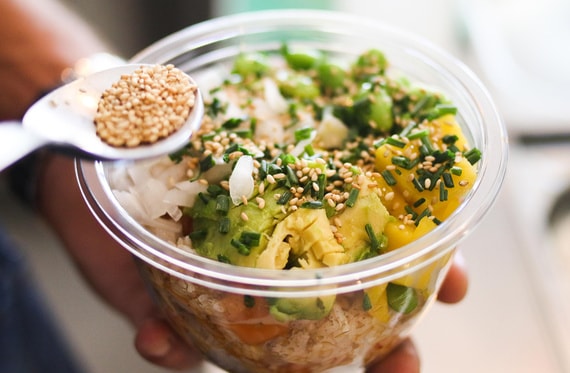
Ohana restaurant © Nacho Sánchez
Who really modernized the neighborhood though, is ‘Ohana’, a hawaïan ‘Poke’ restaurant that occupies the space that the mythic ‘Burguer la Playa’ left behind, when it moved a couple of streets east. The restaurant was an initiative of Marina García and Fran Montero, also owners of ‘Noviembre’ (in the center of Malaga) and ‘Galerna’ (always in fashion in Pedregalejo).
With a surfer-look made of wood and chalk paint, this is the first establishment in the Costa del Sol that is specialized in this healthy and tasty, rising gastronomy. The owners chose El Palo as a location because “it’s a traditional place that is growing and allows us to use fresh, ecological, season-based products”, they assure.
With these products, they prepare a diverse offer of ‘poké’, although they also give you the option to choose your own ingredients. On top of that, they offer salads, hamburgers and juices, all of these served in recycled –or recyclable- containers. If you want, they’ll bring it to your house. Or even to the beach, if you’re having a swim in the western part of Malaga, between ‘El Candado’ and ‘La Malagueta’, a little beyond ‘El Palo’ territory. What more could you ask for?
English version of the article “El barrio de este verano es El Palo, en Málaga”, written by N. Sánchez / Spain Food Sherpas for traveler.es (28/07/16).
Don’t forget to share this post!
Related Articles
↓
Sign up for our Newsletter and get the inside scoop on our favorite recipes,
exploring and devouring Spain and more.
